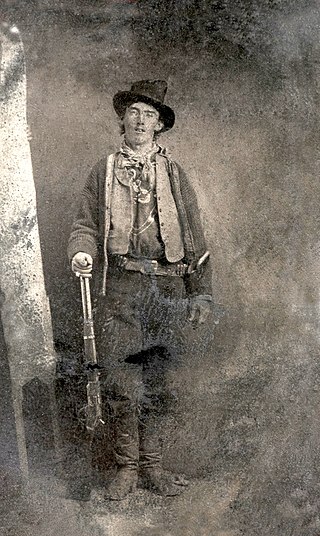
Henry McCarty, alias William H. Bonney, better known as Billy the Kid, was an American outlaw and gunfighter of the Old West who was linked to nine murders: four for which he was solely responsible, and five in which he may have played a role alongside others. He is also noted for his involvement in New Mexico's Lincoln County War.

The Lincoln County War was an Old West conflict between rival factions which began in 1878 in Lincoln County, New Mexico Territory, the predecessor of the state of New Mexico, and continued until 1881. The feud became famous because of the participation of William H. Bonney. Other notable participants included Sheriff William J. Brady, cattle rancher John Chisum, lawyer and businessmen Alexander McSween, James Dolan and Lawrence Murphy.
George Scarborough was a cowboy and lawman who lived during the time of the Wild West. He is best known for having killed outlaw John Selman, killer of John Wesley Hardin, and for his partnership with lawman Jeff Milton, with the pair bringing down several outlaws during their time together.

Gunfighters, also called gunslingers or in the late 19th and early 20th century gunmen, were individuals in the American Old West who gained a reputation of being dangerous with a gun and participated in shootouts. Today, the term "gunslinger" is more or less used to denote someone who is quick on the draw with a handgun, but this can also refer to those armed with rifles and shotguns. The gunfighter is also one of the most popular characters in the Western genre and has appeared in associated films, television shows, video games, and literature.

Henry Newton Brown was an American Old West gunman who played the roles of both lawman and outlaw during his life.
James McIntire was a gunfighter and Texas Ranger in the old west of the United States. He is best known for his autobiography, written in 1902 following a near death experience.
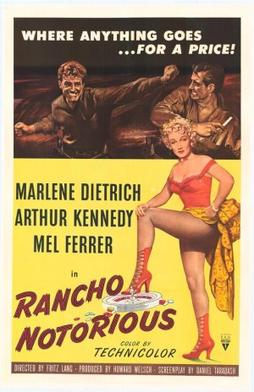
Rancho Notorious is a 1952 American Technicolor western film directed by Fritz Lang and starring Marlene Dietrich as the matron of a criminal hideout called Chuck-a-Luck, named after the game of chance referenced in the film. Arthur Kennedy and Mel Ferrer play rivals for her attention in this tale of frontier revenge.
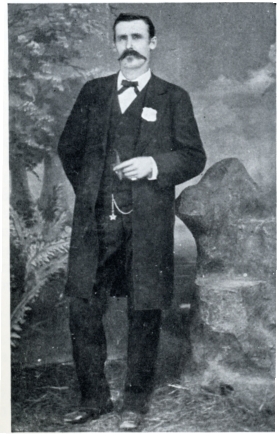
The Four Dead in Five Seconds Gunfight was a famous gun fight that occurred on April 14, 1881, on El Paso Street, in El Paso, Texas. Witnesses generally agreed that the incident lasted no more than five seconds after the first gunshot, though a few would insist it was at least ten seconds. Marshal Dallas Stoudenmire accounted for three of the four fatalities with his twin .44 caliber Smith & Wesson revolvers.
The Gunfight at Hide Park, or the Newton Massacre, was the name given to an Old West gunfight that occurred on August 19, 1871, in Newton, Kansas, United States. While well publicized at the time, the shootout has received little historical attention despite resulting in a higher body count than the Gunfight at the O.K. Corral and the Four Dead in Five Seconds Gunfight of 1881. Unlike most other well-known gunfights of the Old West, it involved no notable or well-known gunfighters, nor did it propel any of its participants into any degree of fame. The story has transformed into legend due to reports that one of the participants, James Riley, walked away from the scene and was never seen again.
Andrew L. "Buckshot" Roberts was an American buffalo hunter, frontiersman and cowboy known for his last stand against the Lincoln County Regulators during the Gunfight of Blazer's Mills near Lincoln, New Mexico.
Mike McCluskie (?-1871) was a little-known gambler and occasional lawman from Ohio, who was the instigator of the Gunfight at Hide Park, which took place on August 19, 1871, in Newton, Kansas.

The Over-the-Hill Gang Rides Again starring Walter Brennan and Fred Astaire is a 1970 ABC Movie of the Week sequel to the Western comedy The Over-the-Hill Gang. The supporting cast includes Edgar Buchanan, Andy Devine, Chill Wills, Lana Wood, and Burt Mustin. Like the 1969 original, the sequel involves a group of aging Texas Rangers and was written by Richard Carr and directed by George McCowan.

Charley Pierce was an American outlaw in the American Old West who rode with both the Dalton Gang and the Doolin Dalton Gang during the 1890s. He and "Bittercreek" Newcomb were killed by friends, the Dunn brothers, for bounty money.
The Horrell brothers, sometimes referred to as the lawless Horrell boys, were five brothers from the Horrell family of Lampasas County, Texas, who were outlaws of the Old West, and who committed numerous murders over a five-year period before four of the brothers were killed in different incidents. The brothers are probably best known for the Horrell-Higgins feud, although it resulted in relatively few deaths compared to other feuds. However, starting in 1873, the brothers went on an ethnically motivated killing spree during which they killed a Hispanic lawman and a white lawman in New Mexico, killed 11 other Hispanic men, and wounded one Hispanic woman. The brothers had previously killed five lawmen in Texas.
John Pinckney Calhoun Higgins, better known as "Pink" Higgins, was a gunman and cowboy of the Old West. He is known to have killed 14 men in his lifetime.
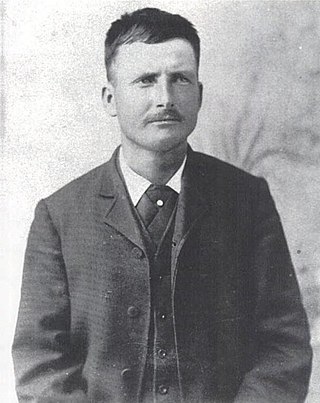
Dan Bogan was an American gunfighter and outlaw of the American Old West, is described as one of the most underrated gunmen of the 19th century west in the book "Deadly Dozen", by author Robert K. DeArment.
Fuzzy Settles Down is a 1944 American Western film directed by Sam Newfield.

Feuds in the United States deals with the phenomena of historic blood feuding in the United States. These feuds have been numerous and some became quite vicious. Often, a conflict which may have started out as a rivalry between two individuals or families became further escalated into a clan-wide feud or a range war, involving dozens—or even hundreds—of participants. Below are listed some of the most notable blood feuds in United States history, most of which occurred in the Old West.
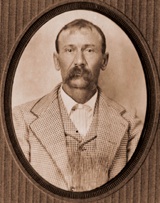
Bill Downing a.k.a. William F. Downing was a notorious outlaw during the Wild West era in Arizona. Downing had fled from the Texas Rangers posse who was after him when he came to Arizona. In Arizona, he was involved in the killing of William S. “Slim” Traynor and in various train robberies including the robbery of the Train Depot in the town of Cochise. Downing was so unpopular that even members of his gang couldn't stand him.
James W. Bell, also referred to as "Long" Bell, "Lone" Bell or Jim Long, was a Deputy Sheriff of the United States Marshals Service. He was shot and killed by Billy the Kid during his escape from Lincoln County jail on 28 April 1881.










